To many around the world, Cartier is synonymous with fine jewelry, whether that’s bracelets or engagement rings. Cartier rocks at everything sparkly, And aside from jewelry, Cartier is also home to many iconic timepieces – with the undoubted crown jewel being the Cartier Tank. So, with price ranges of three thousand to a hundred thousand dollars retail, let’s ask the question: Is it worth it?
History of Cartier
Cartier can trace its roots back to 1847 when Louis-Francois Cartier purchased the small jewelry store where he was an apprentice at. In the beginning, Louis focused on extremely artisanal designs. Still, it was his son Alfred who was a really good salesperson and really pushed Cartier into the minds of the Parisian elite. Then, in the early 20th century, it was Alfred’s three sons that really pushed Cartier even further forward.
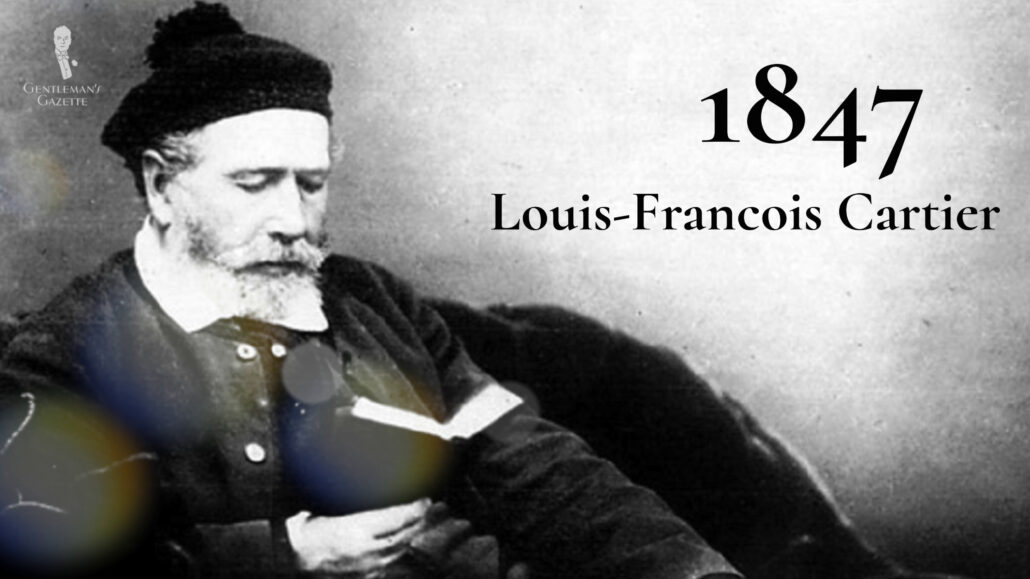
His eldest son, the famous Louis Cartier, managed the Parisian Cartier store. Louis assumed creative control and really defined the Cartier aesthetic. He took inspiration from the bold designs of the art deco movement.
And what do we mean by art deco? Well, take a look at the Chrysler Building, for example, or the illustrations of George Barbier or the art style of Batman the Animated Series.
Meanwhile, while Louis was doing design, many of his other brothers were expanding the brand worldwide. For example, in 1902 Pierre Cartier established the first store in London, and his younger brother Jacques would later take over and move the Cartier store to its iconic location – now present on New Bond Street.

And in 1909, Pierre took Cartier to America, putting it on Fifth Avenue in New York. But, before they came to America, five years earlier, actually, in 1904, Cartier developed their first men’s wristwatch.
The first wristwatch was created after Cartier’s friend, Brazilian aviator Alberto Santos-Dumont, complained about the complexity of wearing a pocket watch while trying to fly. Louis was inspired to make a small, square, and thin watch, which is the Santos, and this watch entered mass production in 1911.

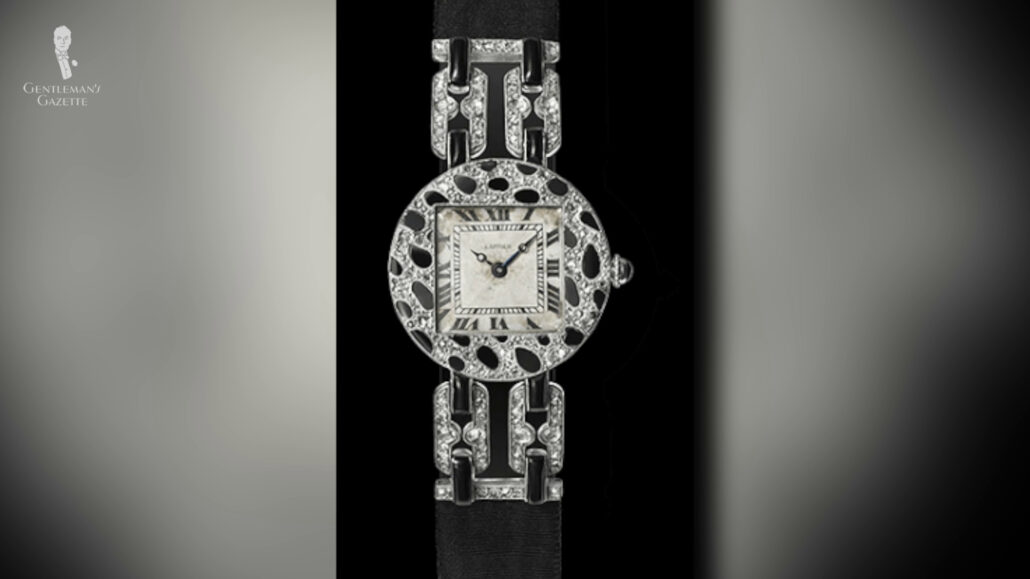
Shortly thereafter, Louis met Jeanne Toussaint, a French and Belgian jewelry and fashion designer. Known by the nickname “Pantheré,” which would be a leopard or panther in French. Toussaint helped Louis with many new designs, including a new ladies’ wristwatch called the “La Pantheré” in 1914. This watch featured a leopard-inspired print made of onyx and diamonds.
Toussaint might have been inspired by big cats, but it would be soon enough that Louis Cartier would be inspired by the big guns.

During World War I, France was really on the edge of modern warfare with this vehicle called the “Tank.” In 1917, Louis Cartier began designing a wristwatch after the French Renault tank, and, of course, Cartier named his watch the “Tank.”
This was one of the first wristwatches with a rectangular case. If you want to read more on another one, check out our guide about the JLC Reverso. The vertical branches of the Cartier Tank watch were very reminiscent of tank treads, and the rectangular case represented the cockpit hatch.
JLC Reverso Watch: Is It Worth It? (Honest Review)

In 1918, Cartier actually gave an early prototype to American tank general John Pershing as a gift of goodwill between the two nations. And in 1919, the Cartier Tank was finally released to the public – all six of them. But, in 1920, production more than quadrupled, with 33 Tanks made.
Throughout the 20s, Cartier released different variations of this iconic design – the ultra-thin, curved Cintrée in 1921, the Chinoise in 1922, the Louis also in 1922, even though it wasn’t called that until 1924, and lastly, the Guichets, which is actually a jump hour model.
By this time in the 1920s, Cartier was leading the way when it came to jewelry and watches. Watches like the Tank could be seen regularly gracing the wrists of members of Hollywood, such as Rudolph Valentin.

“Cartier was the jeweler of kings and the king of jewelers.”
King Edward VII
Image Credit: Savile Row Company
At this time, Cartier was also featured prominently on the wrists of royalty as King Edward VII said that “Cartier was the jeweler of kings and the king of jewelers.” And as time went on, Cartier continued to be featured on the wrists of rulers throughout the world. The 1930s would see two more Tank models, the Basculante in 1932 and the Asymétrique in 1936.
Louis Cartier himself would leave France at the beginning of World War II and would end up passing away in America. After Louis passed away, his brother Pierre took over the company, but Cartier struggled for a while at maintaining its allure.

When Pierre died in 1964, the company actually split into different divisions as different members of the family ran it separately from London, New York, and Paris.
Cartier New York City or NYC was acquired by American businessman Robert Kenmore and he helped to revive the popularity of Cartier and the Tank line by offering more mass-produced and gold-plated versions.
Meanwhile, over in France, French businessman Robert Hocq received a commission from Cartier to start selling lighters. Selling lighters with Cartier was so successful that Robert Hocq was actually able to acquire and reunite the different divisions of Cartier, so he purchased Cartier New York, London, and Paris in 1976.

These three separate divisions were all managed by Hocq’s friend Alain Dominique Perrin. Building on Kenmore’s model, Cartier decided to shift its business approach to offering entry-level and really high-end pieces. Popular lines at this time included the Must de Cartier and the Tank LC. Tanks became famous again and were seen on the wrists of many iconic people, such as Gary Cooper, Andy Warhol, and Elaine Dion.
By the late 70s, Cartier was back in business and spent the 80s really reaffirming itself as a luxury brand. Cartier was even featured on Gordon Gecko’s wrist in the movie Wall Street, which we me a style breakdown about.
Menswear Expert Reviews “Wall Street” (1987)
At this time, in the 1990s, Richemont began a slow and steady process of buying out Cartier, and this was completed in 1998. But, while this was going on, Cartier released two more iconic Tank models – the Tank Americaine in 1989 and the Tank Française in 1996. These were followed by the Divan in 2002 and the Anglaise in 2012.

With this last model, Cartier had special editions that honored the three world powers that stuck together in the First and Second World Wars – Great Britain, France, and the United States, which effectively brought the history of this watch into full cycle.
Cartier Tank Watch – The Hallmark of Sophisticated Elegance
Cartier Tank Today
As we studied the Cartier Tank’s development over the years, there have been many models and subcategories that share the Tank name. So, at this time of filming, those are the Must, the Américaine, the Asymetrique, the Chinoise, the Cintreé, the Francaise, the Louis, and the MC.

And the last one, the MC stands for a “Manufacturer Cartier,” meaning, by “Manufacturer Cartier,” that the movement is in-house. Keep in mind that in-house movements are not always common as there’s something that has to be uniquely designed by their brand and, therefore, demand a premium price.
All these different sub-collections have variations in style and color, so whether you like the unique styling of the Asymetrique or the modern lines of the Americaine, there’s bound to be a Tank for everyone’s taste.

That being said, this post will be extremely long if we look into all of them. So, we’re going to look at the Tank Must and the Tank Louis as the most original and accurate representations of the Cartier Tank.
Cartier Tank Must
Starting with the Must, we can see a design that’s very faithful to the original. It’s finished in a stainless steel case with a silver dial and features a set of blued, sword-shaped hour and minute hands with no seconds hand. You’ll find the same art deco-inspired layout on all the Tank watches, shown in a 12-hour layout in Roman numerals.

The crown showcases a beaded design, into which is set a synthetic sapphire cabochon. It comes on a black grain calfskin strap with a steel buckle in the iconic Cartier design. Although, you can purchase a Must with a steel bracelet as well.
The Must comes in three sizes; small, which is 29.5 by 22 millimeters; large, which is 33.7 by 25.5 millimeters; and extra large, which is 41 by 31 millimeters.
The extra-large models feature the addition of a secondhand, as well as a date window at the six o’clock position. They’re also powered by an automatic movement, whereas the other smaller Must models all have a quartz movement.
Watch Movements Explained
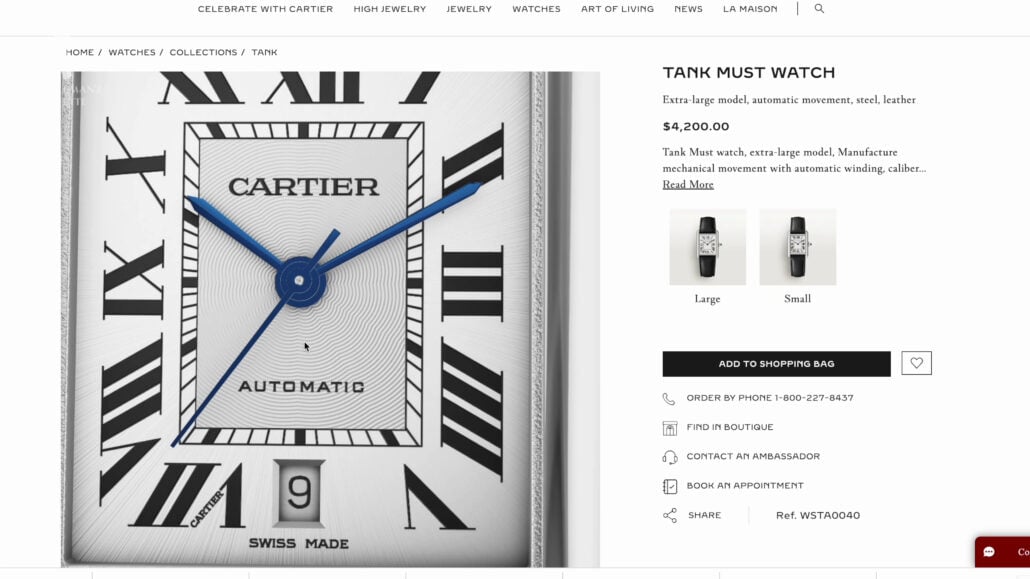
All the Must models have a water resistance of three bar or 30 meters. But, keep in mind, even though most people don’t even swim down to 30 meters, 30 meters really means only splashproof, so don’t take this in the pool or in the shower.
Prices for the Must collection increase in line with the size of the watch and the materials used. They start off at $2,610 for the small size on a leather strap, and they reach $7,150 for the largest size with diamonds on the case.
Tank Louis

Moving on to the Tank Louis, where you’ll see more variety within the range. The sizes are very similar to what you’ll find in the Must collection, with three different sizes to choose from. There’s a small, at 29.5 by 22 millimeters, a large, which is 33.7 by 25.5 millimeters, and an extra large size measuring 40.4 by 34 4.9 millimeters.
One of the big differences is that nearly every model of the Louis line has a hand-wound movement, with the small exception of the small and large sizes at the entry-level, which have quartz movements.
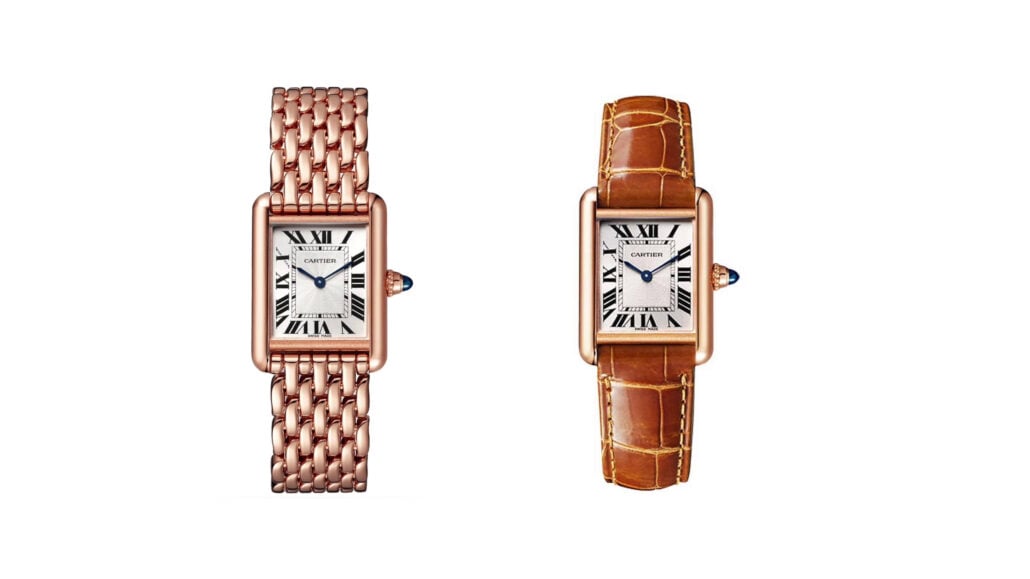
It’s interesting because these two quartz models are the only ones that feature yellow gold on the cases. The rest of the collection opts for rose gold or white gold as the case material. The theme of luxurious materials carries on to the watch strap with either rose gold metal bracelets or genuine alligator skin straps.
As we’ve discussed in another post, not all alligator skins are made the same. But, with that being said, Cartier has a reputation for making fine leather goods, so we would expect that the leather is up to snuff.
Why Are Crocodile & Alligator Leather Goods So Expensive?

Most of the styling details remain consistent throughout the Louis line, but unlike the Must models, none of the Louis models feature a second hand or a date, and that includes even the extra large size.
On the crown, you’ll find a genuine sapphire crystal cabochon. This Sapphire on the crown is a signature of a fine Cartier timepiece, and the hands are blue to match.
Is It Worth It?
So, our most eagle-eyed viewers might have noticed that as we go through these different models, we mentioned small sizes and watches that have diamonds on them, and you might ask why that is.

Well, it’s because Cartier markets them as women’s watches, while they market the large and extra large sizes as men’s watches. Prices for the Tank Louis start at $9,550 for a small model in yellow gold, and they climb to $39,000 for the large model, finished from head-to-toe in rose gold with diamonds.
But, if you find that the smallest size Cartier fits well on your wrist, wear it well, wear it proudly, and no one will say anything. Because the reality is these watches look great regardless of their size.
And as for diamonds, it’s not personally my thing, but if it’s your thing, go for it. I mean, after all, what makes the Cartier Tank so iconic is the fact that it is so wearable, which is good for you because it allows you to invest in one watch and really wear it with everything, which is especially helpful if you’re into classic style.

The hand-wound movement in the Louis line might not be for everyone as it will require a little bit extra attention to your watch. And also, in saying that the Louis might be a detractor for many because of this steep price point.
Personally, I like the gold tones in the Louis watches and the hand-wound movement. I think that the gold adds a warmth that you really don’t find in stainless steel. But, the gold isn’t enough to make me want to spend $11,000 on a quartz movement, so buying the Cartier Tank Louis new is really not worth it, in my opinion.

But with the vintage market being an absolute treasure trove when it comes to Tanks, there really are a lot of great options at different budgets for you. The hunt is a lot of fun, and I’d rather spend the time looking around to find a good deal on a used one.
After all, the Tank’s design has remained iconic throughout the years, so really, only a true enthusiast would know if it isn’t brand new.
That leaves us with the Cartier Tank Must, which, for $3,000, is a heck of a deal. If you compare it to the Rolex Submariner, which is an equally-iconic luxury watch, you can see there is quite a difference in price.

If you want to buy a Submariner, you will end up spending several times the amount of a Cartier Tank and, as Raphael discussed in another guide, he doesn’t really find it a very versatile watch. But, since the Cartier Tank was so popular in the 70s and 80s, the gently-used market is flooded with them, with some only being several hundred to maybe a thousand dollars.
For the timeless styling and the ability to wear it with almost anything and an iconic design, I would say that the Cartier Tank Must is absolutely worth it.

So, what do you think of our Cartier conclusion? Do you agree with us, or do you disagree? Leave your comments down below.
Outfit Rundown
In today’s outfit, I’m wearing something pretty casual, and I’m not actually wearing a watch. It features a suede leather jacket from The Jacket Maker, a plain gray T-shirt, a brown leather belt, blue denim jeans, and a pair of suede boots. I’m also wearing our Fort Belvedere shadow-stripe socks in navy blue and yellow, which pick up the blue in my denim blue jeans.
So, if you like these socks or want to pick up any other Fort Belvedere products, you can check out the shop here.
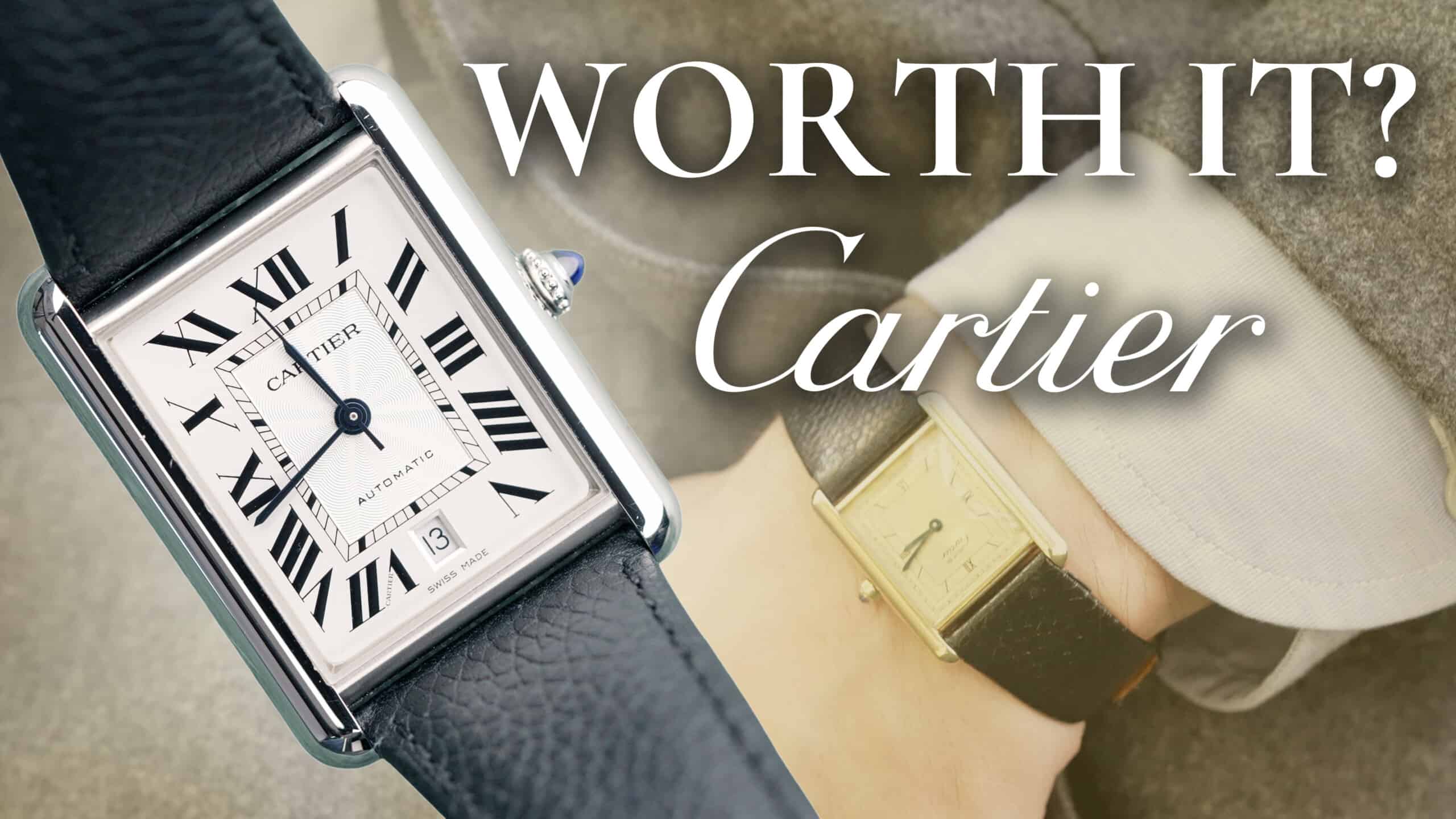



If one is wearing it because one likes the appearance, period, there are excellent knock-offs available,and I do mean excellent.
Greetings,
Better to wear an honest, distinctive Fossil or functional Fitbit than a knock-off of any luxury brand.
Authenticity is key to a gentleman’s integrity.
If a guy is content to attempt passing off a “Fauxlex” in hopes of achieving an expression of his genuinity, what other slipshod misreprentations is he willing to sponsor?
Respectfully,
Andrew Gregg.
Palm Springs, California.
Authenticity is absolutely key, Andrew. I think it’s important to consider the difference between an actual “knock-off” (or counterfeit) item that says it is an original, and an item that is similar but not saying it is an original. Each to their own, but I don’t think there’s anything wrong with enjoying a lower-priced-than-luxury watch with shared design features, like the ones we mention in our alternatives to luxury watches or our 16 Rolex alternatives. Of course, as long as an alternative isn’t being flouted as an original, I can see how authenticity can be retained by simply stating: “I admire the look of the original watch, and I value that the piece I’m wearing balances style and cost for me.”